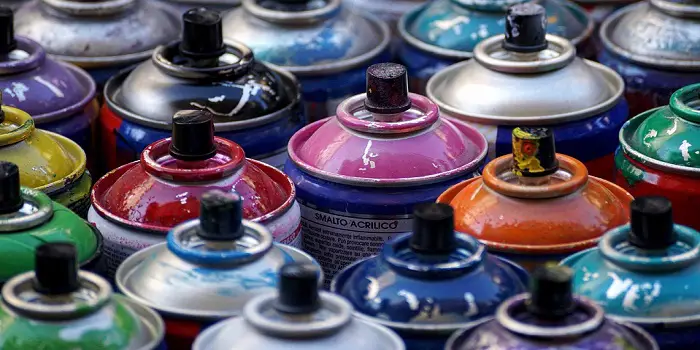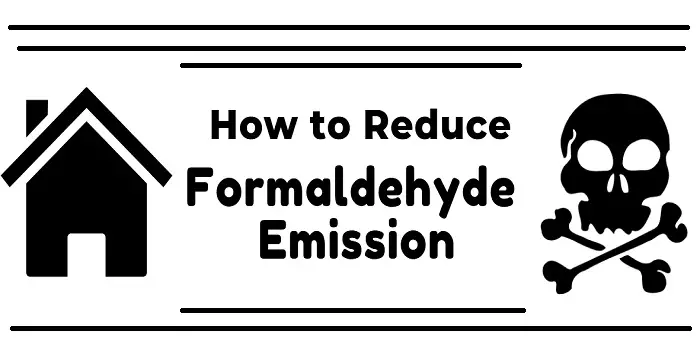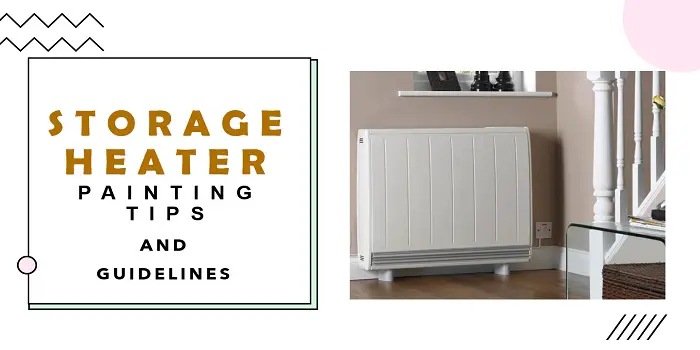
Knowing where formaldehyde can be found in the home is the first step toward reducing or eliminating its presence.
The problem is that formaldehyde is quite common and may be spread throughout your home.
Even when you are planning to paint your house, you should know whether the paint you have chosen contains formaldehyde.
If it does, you should pay special attention to handling such paint products.
Is there formaldehyde present in all paint products?
No, it’s not an active ingredient in paints, coatings & paint thinners manufactured in the U.S.
However, to stop the bacterial and fungal growth, there are traces of formaldehyde added in some paint varieties that expose homeowners to a small amount of formaldehyde in the air.
Many other products where formaldehyde can be present in trace quantities also include:
- Wood products such as MDF, OSB, particle boards, and plywood
- Adhesives, glues & resins used in building materials such as composite wood
- Household fabrics, soft furnishings, and laundry detergent
- Combustibles, such as gas, kerosene heaters, fireplaces, cigarettes, and more
- Certain beauty products like nail polish, nail polish remover, body wash, hair sprays/straighteners
Keep in mind that these are likely places for formaldehyde to be found, but the substance is not always present in many of these items.
Nor may they cause elevated levels of formaldehyde in the home, but they are good places to start.
So now that you know where formaldehyde can be found, the next point is what exactly it is, why it matters so much, and what you can do about it.
What is Formaldehyde?
Formaldehyde is a colorless chemical compound (made of hydrogen, oxygen, and carbon).
It naturally occurs in the environment and can be produced in traces all the time by many living organisms as part of their normal metabolic processes.
The compound is used in various manufacturing processes.
It’s also used as an industrial fungicide, germicide, and disinfectant.
Also, it is many times used as a preservative in mortuaries and medical laboratories.
Formaldehyde can easily become a gas at room temperature and possess a strong pickle-like smell, due to which it’s made a part of a chemical group known as volatile organic compounds (VOCs).
In 2011, formaldehyde was put on the Group 1 list of carcinogens, which means that exposure to the chemical may lead to cancer.
This is true even if the exposure is in low amounts over a long period.
Since formaldehyde can be generated in the home, this means that everyone living inside suffers from an increased risk of contracting health-related problems.
So, how can formaldehyde be removed from the home without causing even more complicating issues?
Furthermore, can it be prevented from being introduced inside the home?
There are some simple, cost-efficient methods that can reduce the amount of formaldehyde present, but everything begins with identifying the sources.

Different Ways to Reduce Formaldehyde in Your Home
Although invisible to the naked eye, the strong, pungent smell of formaldehyde becomes noticeable at high levels.
However, most freshly painted homes have low levels that can only be tracked using a good indoor air quality monitor.
In general, formaldehyde levels should remain below 0.03 ppm (parts per million).
And if you suspect that your home has higher than normal levels, these are nine simple, direct ways you can use to reduce the amount of formaldehyde in the home.
Many of these steps cost little to no money. And in a few cases may save you money.
1- Ventilate
One of the best ways to combat the buildup of formaldehyde in the home is to ventilate properly.
This means opening the windows on warm days and running the fans to usher the indoor air outside and bring in the new, fresh air that is free of formaldehyde and other unwanted particles.
Of course, if the outside air is polluted or if the ozone level is high, then you will need to wait for days until the pollution is reduced.
The presence of ozone will increase the amount of formaldehyde present in the air.
This means you should not purchase air purifiers with an ozone generator as they will cause more harm than good.
2- Purchase an Air Purifier
It will work if you purchase one that is best suited for the width and height of the room where it will be placed.
It will need to cycle the air at least three times per hour and use active carbon filters which can remove the formaldehyde.
The heavier the active carbon filter, the better as it will trap more formaldehyde within.
However, one potential issue, even with the best air purifiers, is that they may increase the humidity levels, which in turn increases the presence of volatile organic compounds (VOCs) that may be present in the paint on the walls.
Be sure to purchase a dehumidifier if the sprayed paint on the interior walls has VOCs.
Make it a habit of opening the windows and the doors if they have screen doors in front at the most opportune times.
Keep in mind that it’s cheaper to ventilate your home during the time when the outdoor air is comfortable compared to running the A/C.
You can get apps for your smartphone that let you know the best times to open the windows and let in the fresh air.
3- Clean Fireplaces & Wood-Burning Stoves Regularly
Combustible sources are the first place to address when reducing the amount of formaldehyde in the home.
This means any source of combustion such as the fireplace, kerosene, natural gas, or wood-burning stove.
Be sure to clean such areas regularly and do so with plenty of ventilation present.
Plus, dryers and furnaces that run on natural gas are also sources of formaldehyde.
So, you should test the exhaust fans to see if they move the heated air outside.
In addition to reducing formaldehyde, it can also reduce the amount of deadly carbon monoxide in the home.
4- Do Not Smoke Inside the Home
Because formaldehyde is a byproduct of combustion, it can be found in cigarette or tobacco smoke.
By eliminating smoking from inside your home, you can eliminate this source of formaldehyde.
Set rules that people are to smoke outside your home.
Once you have established that rule, you can purchase small carbon bags that activate and absorb the lingering smoke particles from inside your home.
5- Check Old Insulation
Back in the 1970s through the early 1980s, a popular form of insulation that used formaldehyde was introduced into homes.
If your home was built during that time or had its insulation replaced during that era, then it is highly likely that it contains formaldehyde.
It is true that most of the formaldehyde will have been released and is gone from the home, but you can have it checked just to be sure.
Replacing the insulation with a new type is a good idea if you are planning on renovating the home.
Keep in mind that there are still exterior insulation products that may contain formaldehyde, but they should be safe if they stay outside.
In addition, you should remove any wallpaper that has adhesives because that may contain formaldehyde.
6- Eliminate Composite Wood
You can find this type of wood in laminate flooring and painted furniture.
If you choose real wood for your furniture, then you have nothing to worry about since no formaldehyde should be present.
If you do choose composite wood, then let it air out on the porch or backyard to release most, if not all, the formaldehyde before bringing it into the home.
New laminate flooring has little to no formaldehyde, but older versions may still have some present.
If you plan on a renovation, then this is the time to remove the older laminate flooring.
However, as with older composite wood products, it may have released most, if not all, formaldehyde present.
Ventilate the room and then have the home tested for the presence of formaldehyde.
7- Never Run Your Vehicle Inside a Closed Garage
This should be a no-brainer, but your vehicle is not only a source of formaldehyde but also a source of deadly carbon monoxide, which may lead to serious injury and often death.
If you must run your vehicle inside the garage, then open the garage door first to let out the air.
Ideally, you should never let your vehicle idle inside the garage at all.
To be extra safe, you should seal all entrances from the garage to your home.
This means making sure the door to the garage is shut tight. Plus, any openings in the ceiling or walls are sealed as well.
8- Get Organic Materials for Your Home
Because items made from organic materials undergo fewer processes that expose them to formaldehyde, they are generally safer than non-organic substances.
You can find organic products used for upholstery, mattresses, and bedding.
Look for labels that tell you the product is organic and free of toxins.
It is true that organic pillows and pillowcases are far less expensive compared to replacing your mattress.
If you purchase a new mattress that is not organic, let it air out in an open space before introducing it to the home.
Natural materials can also be found in upholstery, curtains, and other fabrics.
Be sure to purchase them for your bedroom, living room, and other areas of the home.
You’ll want to avoid organic products that have extensive chemical treatment.
Terms such as “wrinkle-free” or “fire-retardant” will likely have formaldehyde or other unwanted chemicals.
You can always purchase a steamer to keep your curtains and other fabrics made from organic materials free of wrinkles.
9- Seal the Surfaces
If you want more protection from items that may emit formaldehyde, then sealing the coated surfaces where applicable can help.
You need to ensure that the paint sealant does not contain formaldehyde and should not present a danger to the home.
For flooring, you need to choose a sealant that is safe and approved by the US Consumer Product Safety Commission.
Sealants like wax may be more difficult to maintain, but they are natural products and have little to no formaldehyde present.
Another choice is water-based stains as they are more environmentally friendly.
However, they are more difficult to apply and maintain compared to oil-based stains.
You may want to go with the latter if the oil has few objectionable materials.
Final Thoughts
Although most paint products (latex as well as oil-based) contain formaldehyde in traces, they can still cause various health issues.
While you can never eliminate formaldehyde completely, keep in mind that you can address the levels in your home gradually.
Start by increasing ventilation and then begin replacing or sealing the items that are generating the formaldehyde.
And when planning for a home renovation, consider less toxic latex-based formaldehyde-free paint options if possible.
Share the post "Is There Formaldehyde in Paint? (Answered & Few Fixes)"

Douglas Becker (aka Painter Doug) has over twenty years of experience as a painter in Adkins, Texas. At present, he resides in Florida with his family.
From painting multi-storeyed houses, condos, and apartments to large commercial buildings and small offices, he had served various customers in areas not only in Adkins but also in Southwest Florida, Sarasota, Naples, and many more. To know more about him check here.





